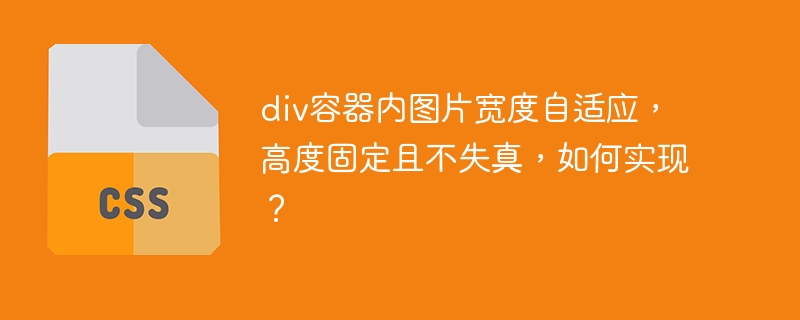 Web Front-end
Web Front-end
 CSS Tutorial
CSS Tutorial
 The image width in the div container is adaptive, the height is fixed and not distorted. How to achieve it?
The image width in the div container is adaptive, the height is fixed and not distorted. How to achieve it?
The image width in the div container is adaptive, the height is fixed and not distorted. How to achieve it?

Adaptive display of web pictures: maintain proportions and avoid deformation
Image resizing is a common problem in web design. When the image width exceeds the container, how to maintain the image proportion without distortion is a challenge for many developers. This article will explain in detail how to solve this problem through a case.
Problem: A div container with a width of 50% needs to hold a wide picture. Putting it in directly will cause the picture to be compressed and deformed. The goal is: the image height is fixed, the width is automatically adapted to the container, while maintaining the original proportions to avoid distortion.
Initial code:
<div style="width:50%;"> <img src="/static/imghw/default1.png" data-src="https://img.php.cn/upload/article/001/246/273/174277896468460.png" class="lazy" alt="The image width in the div container is adaptive, the height is fixed and not distorted. How to achieve it?"> </div>
Solution: Use CSS attributes to control the image display method to achieve adaptive image width and fixed height.
Modified code:
<div style="width:50%; height: 200px;"> <!-- Added parent container height --> <img src="/static/imghw/default1.png" data-src="/seller/templates/img/bg_logo_left.png" class="lazy" alt="" style="max-width:90%"> </div>
With width: auto; height: 100%; , the image width will be automatically adjusted according to the container width, and the height will be set to 100% of the container height. In this way, the picture can maintain its original proportion and be displayed in the container intact to avoid deformation.
Key point: The parent container div must set a clear height (for example, height: 200px; or use other methods to determine the height), otherwise the image height cannot be determined and the adaptive effect cannot be achieved. You can adjust the height of the parent container according to actual needs.
Through the above methods, you can easily solve the problem of adaptive width, fixed height and undistorted images in the div container, improving the overall effect of web page layout.
The above is the detailed content of The image width in the div container is adaptive, the height is fixed and not distorted. How to achieve it?. For more information, please follow other related articles on the PHP Chinese website!

Hot AI Tools

Undresser.AI Undress
AI-powered app for creating realistic nude photos

AI Clothes Remover
Online AI tool for removing clothes from photos.

Undress AI Tool
Undress images for free

Clothoff.io
AI clothes remover

Video Face Swap
Swap faces in any video effortlessly with our completely free AI face swap tool!

Hot Article

Hot Tools

Notepad++7.3.1
Easy-to-use and free code editor

SublimeText3 Chinese version
Chinese version, very easy to use

Zend Studio 13.0.1
Powerful PHP integrated development environment

Dreamweaver CS6
Visual web development tools

SublimeText3 Mac version
God-level code editing software (SublimeText3)

Hot Topics
 How to use bootstrap in vue
Apr 07, 2025 pm 11:33 PM
How to use bootstrap in vue
Apr 07, 2025 pm 11:33 PM
Using Bootstrap in Vue.js is divided into five steps: Install Bootstrap. Import Bootstrap in main.js. Use the Bootstrap component directly in the template. Optional: Custom style. Optional: Use plug-ins.
 The Roles of HTML, CSS, and JavaScript: Core Responsibilities
Apr 08, 2025 pm 07:05 PM
The Roles of HTML, CSS, and JavaScript: Core Responsibilities
Apr 08, 2025 pm 07:05 PM
HTML defines the web structure, CSS is responsible for style and layout, and JavaScript gives dynamic interaction. The three perform their duties in web development and jointly build a colorful website.
 Understanding HTML, CSS, and JavaScript: A Beginner's Guide
Apr 12, 2025 am 12:02 AM
Understanding HTML, CSS, and JavaScript: A Beginner's Guide
Apr 12, 2025 am 12:02 AM
WebdevelopmentreliesonHTML,CSS,andJavaScript:1)HTMLstructurescontent,2)CSSstylesit,and3)JavaScriptaddsinteractivity,formingthebasisofmodernwebexperiences.
 How to set up the framework for bootstrap
Apr 07, 2025 pm 03:27 PM
How to set up the framework for bootstrap
Apr 07, 2025 pm 03:27 PM
To set up the Bootstrap framework, you need to follow these steps: 1. Reference the Bootstrap file via CDN; 2. Download and host the file on your own server; 3. Include the Bootstrap file in HTML; 4. Compile Sass/Less as needed; 5. Import a custom file (optional). Once setup is complete, you can use Bootstrap's grid systems, components, and styles to create responsive websites and applications.
 How to write split lines on bootstrap
Apr 07, 2025 pm 03:12 PM
How to write split lines on bootstrap
Apr 07, 2025 pm 03:12 PM
There are two ways to create a Bootstrap split line: using the tag, which creates a horizontal split line. Use the CSS border property to create custom style split lines.
 How to insert pictures on bootstrap
Apr 07, 2025 pm 03:30 PM
How to insert pictures on bootstrap
Apr 07, 2025 pm 03:30 PM
There are several ways to insert images in Bootstrap: insert images directly, using the HTML img tag. With the Bootstrap image component, you can provide responsive images and more styles. Set the image size, use the img-fluid class to make the image adaptable. Set the border, using the img-bordered class. Set the rounded corners and use the img-rounded class. Set the shadow, use the shadow class. Resize and position the image, using CSS style. Using the background image, use the background-image CSS property.
 How to use bootstrap button
Apr 07, 2025 pm 03:09 PM
How to use bootstrap button
Apr 07, 2025 pm 03:09 PM
How to use the Bootstrap button? Introduce Bootstrap CSS to create button elements and add Bootstrap button class to add button text
 How to resize bootstrap
Apr 07, 2025 pm 03:18 PM
How to resize bootstrap
Apr 07, 2025 pm 03:18 PM
To adjust the size of elements in Bootstrap, you can use the dimension class, which includes: adjusting width: .col-, .w-, .mw-adjust height: .h-, .min-h-, .max-h-





